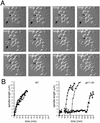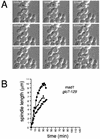Defects in Saccharomyces cerevisiae protein phosphatase type I activate the spindle/kinetochore checkpoint
- PMID: 10072380
- PMCID: PMC316501
- DOI: 10.1101/gad.13.5.517
Defects in Saccharomyces cerevisiae protein phosphatase type I activate the spindle/kinetochore checkpoint
Abstract
A conditional allele of type 1 protein phosphatase (glc7-129) in Saccharomyces cerevisiae causes first cycle arrest in G2/M, characterized by cells with a short spindle and high H1 kinase activity. Point-of-execution experiments indicate Glc7p function is required in G2/M just before anaphase for the completion of mitosis. Loss of the spindle/kinetochore checkpoint in glc7-129 cells abolishes the G2/M cell cycle arrest with a concomitant increase in chromosome loss and reduced viability. These results support a role for Glc7p in regulating kinetochore attachment to the spindle, an event monitored by the spindle/kinetochore checkpoint.
Figures




Similar articles
-
Regulation of Saccharomyces cerevisiae kinetochores by the type 1 phosphatase Glc7p.Genes Dev. 1999 Mar 1;13(5):545-55. doi: 10.1101/gad.13.5.545. Genes Dev. 1999. PMID: 10072383 Free PMC article.
-
Cdc55p, the B-type regulatory subunit of protein phosphatase 2A, has multiple functions in mitosis and is required for the kinetochore/spindle checkpoint in Saccharomyces cerevisiae.Mol Cell Biol. 1997 Feb;17(2):620-6. doi: 10.1128/MCB.17.2.620. Mol Cell Biol. 1997. PMID: 9001215 Free PMC article.
-
The highly conserved Ndc80 complex is required for kinetochore assembly, chromosome congression, and spindle checkpoint activity.Genes Dev. 2003 Jan 1;17(1):101-14. doi: 10.1101/gad.1040903. Genes Dev. 2003. PMID: 12514103 Free PMC article.
-
Kinetochore structure and spindle assembly checkpoint signaling in the budding yeast, Saccharomyces cerevisiae.Front Biosci. 2008 May 1;13:6787-819. doi: 10.2741/3189. Front Biosci. 2008. PMID: 18508695 Review.
-
Chromosome segregation: dual control ensures fidelity.Curr Biol. 1999 Jul 29-Aug 12;9(15):R562-4. doi: 10.1016/s0960-9822(99)80355-8. Curr Biol. 1999. PMID: 10469560 Review.
Cited by
-
A Bni4-Glc7 phosphatase complex that recruits chitin synthase to the site of bud emergence.Mol Biol Cell. 2003 Jan;14(1):26-39. doi: 10.1091/mbc.e02-06-0373. Mol Biol Cell. 2003. PMID: 12529424 Free PMC article.
-
Cdc20 associates with the kinase aurora2/Aik.Proc Natl Acad Sci U S A. 1999 Jun 22;96(13):7306-11. doi: 10.1073/pnas.96.13.7306. Proc Natl Acad Sci U S A. 1999. PMID: 10377410 Free PMC article.
-
Suppressors of ipl1-2 in components of a Glc7 phosphatase complex, Cdc48 AAA ATPase, TORC1, and the kinetochore.G3 (Bethesda). 2012 Dec;2(12):1687-701. doi: 10.1534/g3.112.003814. Epub 2012 Dec 1. G3 (Bethesda). 2012. PMID: 23275890 Free PMC article.
-
Glc7/protein phosphatase 1 regulatory subunits can oppose the Ipl1/aurora protein kinase by redistributing Glc7.Mol Cell Biol. 2006 Apr;26(7):2648-60. doi: 10.1128/MCB.26.7.2648-2660.2006. Mol Cell Biol. 2006. PMID: 16537909 Free PMC article.
-
Ypi1, a positive regulator of nuclear protein phosphatase type 1 activity in Saccharomyces cerevisiae.Mol Biol Cell. 2008 Mar;19(3):1032-45. doi: 10.1091/mbc.e07-05-0499. Epub 2008 Jan 2. Mol Biol Cell. 2008. PMID: 18172024 Free PMC article.
References
-
- Axton JM, Dombradi V, Cohen PTW, Glover DM. One of the protein phosphatase 1 isoenzymes in Drosophila is essential for mitosis. Cell. 1990;63:33–46. - PubMed
-
- Bradford MM. Rapid and sensitive method for quantitation of microgram quantities of protein utilizing the principle of protein-dye binding. Anal Biochem. 1976;72:248–254. - PubMed
-
- Chen RH, Waters JC, Salmon ED, Murray AW. Association of spindle assembly checkpoint component XMAD2 with unattached kinetochores. Science. 1996;274:242–246. - PubMed
-
- Doonan JH, Morris NR. The bimG gene of Aspergillus nidulans, required for completion of anaphase, encodes a homolog of mammalian phosphoprotein phosphatase 1. Cell. 1989;57:987–996. - PubMed
Publication types
MeSH terms
Substances
Grants and funding
LinkOut - more resources
Full Text Sources
Molecular Biology Databases
